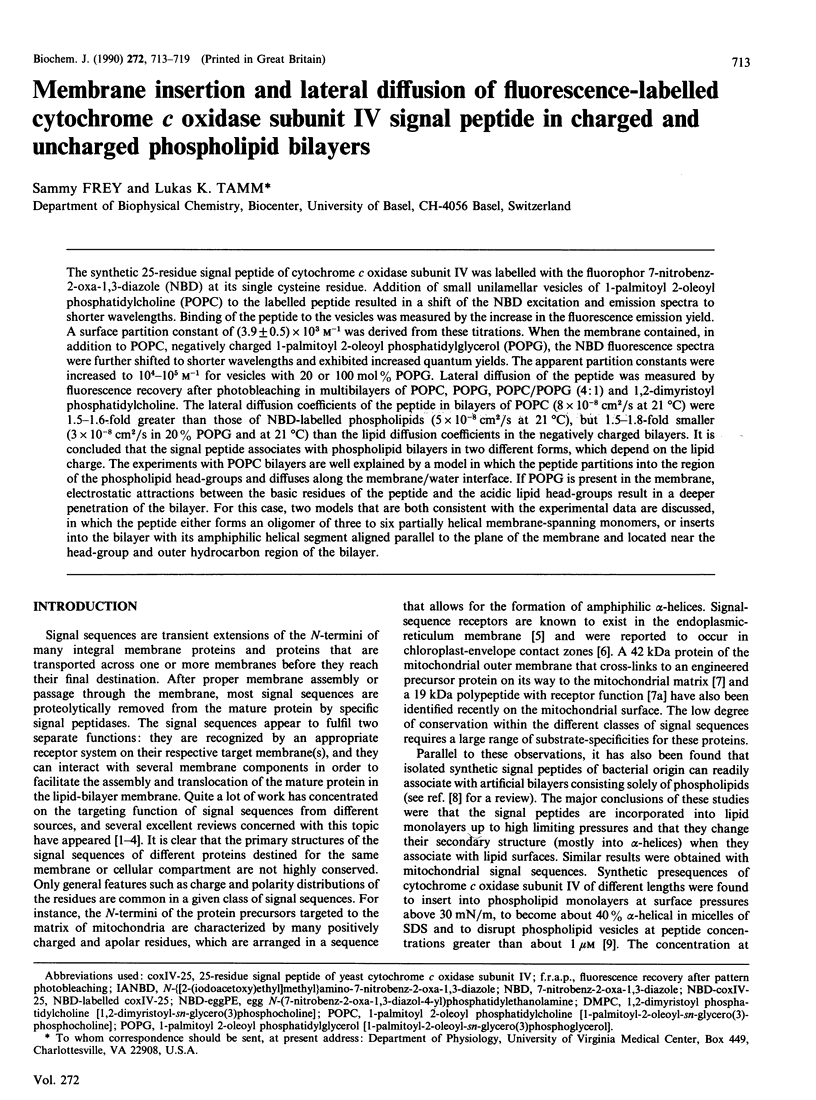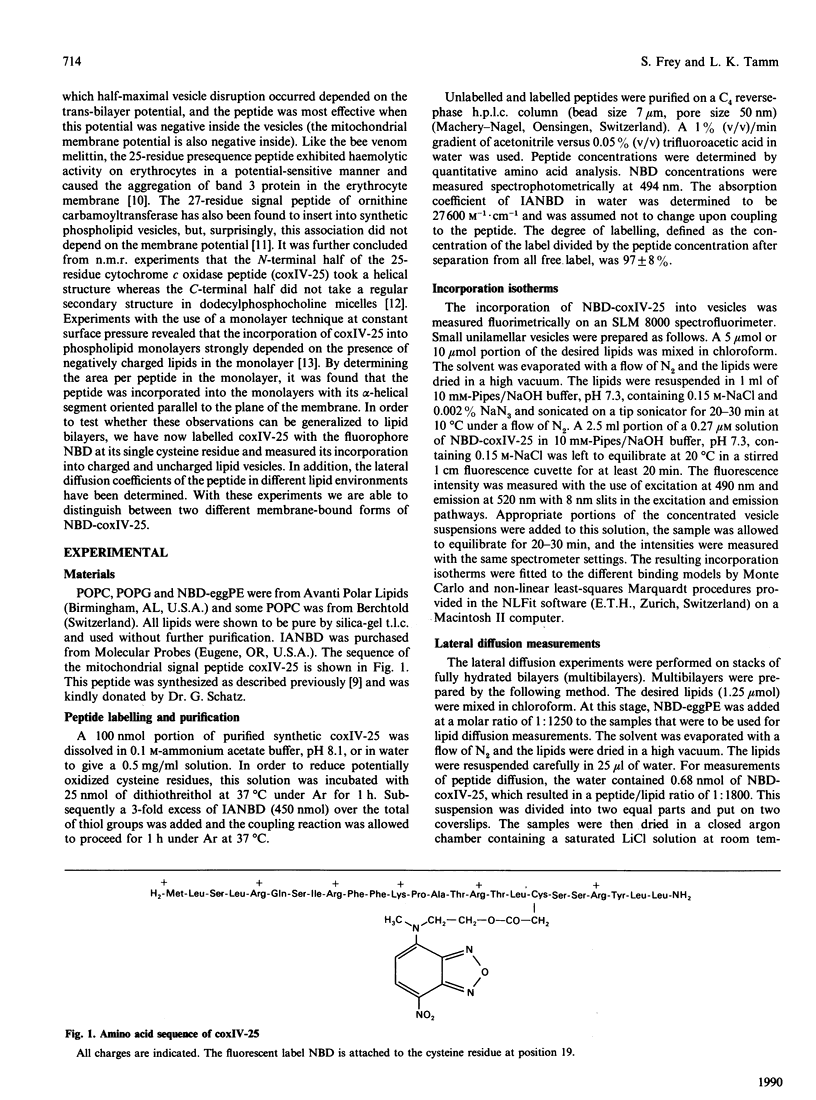Abstract
The synthetic 25-residue signal peptide of cytochrome c oxidase subunit IV was labelled with the fluorophor 7-nitrobenz-2-oxa-1,3-diazole (NBD) at its single cysteine residue. Addition of small unilamellar vesicles of 1-palmitoyl 2-oleoyl phosphatidylcholine (POPC) to the labelled peptide resulted in a shift of the NBD excitation and emission spectra to shorter wavelengths. Binding of the peptide to the vesicles was measured by the increase in the fluorescence emission yield. A surface partition constant of (3.9 +/- 0.5) x 10(3) M-1 was derived from these titrations. When the membrane contained, in addition to POPC, negatively charged 1-palmitoyl 2-oleoyl phosphatidylglycerol (POPG), the NBD fluorescence spectra were further shifted to shorter wavelengths and exhibited increased quantum yields. The apparent partition constants were increased to 10(4)-10(5) M-1 for vesicles with 20 or 100 mol% POPG. Lateral diffusion of the peptide was measured by fluorescence recovery after photobleaching in multibilayers of POPC, POPG, POPC/POPG (4:1) and 1,2-dimyristoyl phosphatidylcholine. The lateral diffusion coefficients of the peptide in bilayers of POPC (8 x 10(-8) cm2/s at 21 degrees C) were 1.5-1.6-fold greater than those of NBD-labelled phospholipids (5 x 10(-8) cm2/s at 21 degrees C), but 1.5-1.8-fold smaller (3 x 10(-8) cm2/s in 20% POPG and at 21 degrees C) than the lipid diffusion coefficients in the negatively charged bilayers. It is concluded that the signal peptide associates with phospholipid bilayers in two different forms, which depend on the lipid charge. The experiments with POPC bilayers are well explained by a model in which the peptide partitions into the region of the phospholipid head-groups and diffuses along the membrane/water interface. If POPG is present in the membrane, electrostatic attractions between the basic residues of the peptide and the acidic lipid head-groups result in a deeper penetration of the bilayer. For this case, two models that are both consistent with the experimental data are discussed, in which the peptide either forms an oligomer of three to six partially helical membrane-spanning monomers, or inserts into the bilayer with its amphiphilic helical segment aligned parallel to the plane of the membrane and located near the head-group and outer hydrocarbon region of the bilayer.
Full text
PDF






Selected References
These references are in PubMed. This may not be the complete list of references from this article.
- Beschiaschvili G., Seelig J. Melittin binding to mixed phosphatidylglycerol/phosphatidylcholine membranes. Biochemistry. 1990 Jan 9;29(1):52–58. doi: 10.1021/bi00453a007. [DOI] [PubMed] [Google Scholar]
- Briggs M. S., Cornell D. G., Dluhy R. A., Gierasch L. M. Conformations of signal peptides induced by lipids suggest initial steps in protein export. Science. 1986 Jul 11;233(4760):206–208. doi: 10.1126/science.2941862. [DOI] [PubMed] [Google Scholar]
- Clague M. J., Cherry R. J. Comparison of p25 presequence peptide and melittin. Red blood cell haemolysis and band 3 aggregation. Biochem J. 1988 Jun 15;252(3):791–794. doi: 10.1042/bj2520791. [DOI] [PMC free article] [PubMed] [Google Scholar]
- Cornell D. G., Dluhy R. A., Briggs M. S., McKnight C. J., Gierasch L. M. Conformations and orientations of a signal peptide interacting with phospholipid monolayers. Biochemistry. 1989 Apr 4;28(7):2789–2797. doi: 10.1021/bi00433a008. [DOI] [PubMed] [Google Scholar]
- Daum G. Lipids of mitochondria. Biochim Biophys Acta. 1985 Jun 12;822(1):1–42. doi: 10.1016/0304-4157(85)90002-4. [DOI] [PubMed] [Google Scholar]
- Endo T., Shimada I., Roise D., Inagaki F. N-terminal half of a mitochondrial presequence peptide takes a helical conformation when bound to dodecylphosphocholine micelles: a proton nuclear magnetic resonance study. J Biochem. 1989 Sep;106(3):396–400. doi: 10.1093/oxfordjournals.jbchem.a122864. [DOI] [PubMed] [Google Scholar]
- Gierasch L. M. Signal sequences. Biochemistry. 1989 Feb 7;28(3):923–930. doi: 10.1021/bi00429a001. [DOI] [PubMed] [Google Scholar]
- Gupte S. S., Hackenbrock C. R. Multidimensional diffusion modes and collision frequencies of cytochrome c with its redox partners. J Biol Chem. 1988 Apr 15;263(11):5241–5247. [PubMed] [Google Scholar]
- Hartl F. U., Pfanner N., Nicholson D. W., Neupert W. Mitochondrial protein import. Biochim Biophys Acta. 1989 Jan 18;988(1):1–45. doi: 10.1016/0304-4157(89)90002-6. [DOI] [PubMed] [Google Scholar]
- Hovius R., Lambrechts H., Nicolay K., de Kruijff B. Improved methods to isolate and subfractionate rat liver mitochondria. Lipid composition of the inner and outer membrane. Biochim Biophys Acta. 1990 Jan 29;1021(2):217–226. doi: 10.1016/0005-2736(90)90036-n. [DOI] [PubMed] [Google Scholar]
- Langner M., Cafiso D., Marcelja S., McLaughlin S. Electrostatics of phosphoinositide bilayer membranes. Theoretical and experimental results. Biophys J. 1990 Feb;57(2):335–349. doi: 10.1016/S0006-3495(90)82535-2. [DOI] [PMC free article] [PubMed] [Google Scholar]
- Pain D., Kanwar Y. S., Blobel G. Identification of a receptor for protein import into chloroplasts and its localization to envelope contact zones. Nature. 1988 Jan 21;331(6153):232–237. doi: 10.1038/331232a0. [DOI] [PubMed] [Google Scholar]
- Peters R., Cherry R. J. Lateral and rotational diffusion of bacteriorhodopsin in lipid bilayers: experimental test of the Saffman-Delbrück equations. Proc Natl Acad Sci U S A. 1982 Jul;79(14):4317–4321. doi: 10.1073/pnas.79.14.4317. [DOI] [PMC free article] [PubMed] [Google Scholar]
- Pfaller R., Neupert W. High-affinity binding sites involved in the import of porin into mitochondria. EMBO J. 1987 Sep;6(9):2635–2642. doi: 10.1002/j.1460-2075.1987.tb02554.x. [DOI] [PMC free article] [PubMed] [Google Scholar]
- Pfaller R., Steger H. F., Rassow J., Pfanner N., Neupert W. Import pathways of precursor proteins into mitochondria: multiple receptor sites are followed by a common membrane insertion site. J Cell Biol. 1988 Dec;107(6 Pt 2):2483–2490. doi: 10.1083/jcb.107.6.2483. [DOI] [PMC free article] [PubMed] [Google Scholar]
- Pfanner N., Pfaller R., Neupert W. How finicky is mitochondrial protein import? Trends Biochem Sci. 1988 May;13(5):165–167. doi: 10.1016/0968-0004(88)90140-5. [DOI] [PubMed] [Google Scholar]
- Roise D., Horvath S. J., Tomich J. M., Richards J. H., Schatz G. A chemically synthesized pre-sequence of an imported mitochondrial protein can form an amphiphilic helix and perturb natural and artificial phospholipid bilayers. EMBO J. 1986 Jun;5(6):1327–1334. doi: 10.1002/j.1460-2075.1986.tb04363.x. [DOI] [PMC free article] [PubMed] [Google Scholar]
- Rothman J. E. Signal-peptide recognition. GTP and methionine bristles. Nature. 1989 Aug 10;340(6233):433–434. doi: 10.1038/340433a0. [DOI] [PubMed] [Google Scholar]
- Seelig A., Macdonald P. M. Binding of a neuropeptide, substance P, to neutral and negatively charged lipids. Biochemistry. 1989 Mar 21;28(6):2490–2496. doi: 10.1021/bi00432a021. [DOI] [PubMed] [Google Scholar]
- Skerjanc I. S., Shore G. C., Silvius J. R. The interaction of a synthetic mitochondrial signal peptide with lipid membranes is independent of transbilayer potential. EMBO J. 1987 Oct;6(10):3117–3123. doi: 10.1002/j.1460-2075.1987.tb02621.x. [DOI] [PMC free article] [PubMed] [Google Scholar]
- Smith B. A., McConnell H. M. Determination of molecular motion in membranes using periodic pattern photobleaching. Proc Natl Acad Sci U S A. 1978 Jun;75(6):2759–2763. doi: 10.1073/pnas.75.6.2759. [DOI] [PMC free article] [PubMed] [Google Scholar]
- Smith L. M., Rubenstein J. L., Parce J. W., McConnell H. M. Lateral diffusion of M-13 coat protein in mixtures of phosphatidylcholine and cholesterol. Biochemistry. 1980 Dec 9;19(25):5907–5911. doi: 10.1021/bi00566a037. [DOI] [PubMed] [Google Scholar]
- Söllner T., Griffiths G., Pfaller R., Pfanner N., Neupert W. MOM19, an import receptor for mitochondrial precursor proteins. Cell. 1989 Dec 22;59(6):1061–1070. doi: 10.1016/0092-8674(89)90762-9. [DOI] [PubMed] [Google Scholar]
- Tamm L. K. Incorporation of a synthetic mitochondrial signal peptide into charged and uncharged phospholipid monolayers. Biochemistry. 1986 Nov 18;25(23):7470–7476. doi: 10.1021/bi00371a032. [DOI] [PubMed] [Google Scholar]
- Tamm L. K. Lateral diffusion and fluorescence microscope studies on a monoclonal antibody specifically bound to supported phospholipid bilayers. Biochemistry. 1988 Mar 8;27(5):1450–1457. doi: 10.1021/bi00405a009. [DOI] [PubMed] [Google Scholar]
- Tank D. W., Wu E. S., Meers P. R., Webb W. W. Lateral diffusion of gramicidin C in phospholipid multibilayers. Effects of cholesterol and high gramicidin concentration. Biophys J. 1982 Nov;40(2):129–135. doi: 10.1016/S0006-3495(82)84467-6. [DOI] [PMC free article] [PubMed] [Google Scholar]
- Verner K., Schatz G. Protein translocation across membranes. Science. 1988 Sep 9;241(4871):1307–1313. doi: 10.1126/science.2842866. [DOI] [PubMed] [Google Scholar]
- Vestweber D., Brunner J., Baker A., Schatz G. A 42K outer-membrane protein is a component of the yeast mitochondrial protein import site. Nature. 1989 Sep 21;341(6239):205–209. doi: 10.1038/341205a0. [DOI] [PubMed] [Google Scholar]
- Wickner W. T., Lodish H. F. Multiple mechanisms of protein insertion into and across membranes. Science. 1985 Oct 25;230(4724):400–407. doi: 10.1126/science.4048938. [DOI] [PubMed] [Google Scholar]
- Wiedmann M., Kurzchalia T. V., Hartmann E., Rapoport T. A. A signal sequence receptor in the endoplasmic reticulum membrane. 1987 Aug 27-Sep 2Nature. 328(6133):830–833. doi: 10.1038/328830a0. [DOI] [PubMed] [Google Scholar]
- von Heijne G. Transcending the impenetrable: how proteins come to terms with membranes. Biochim Biophys Acta. 1988 Jun 9;947(2):307–333. doi: 10.1016/0304-4157(88)90013-5. [DOI] [PubMed] [Google Scholar]


